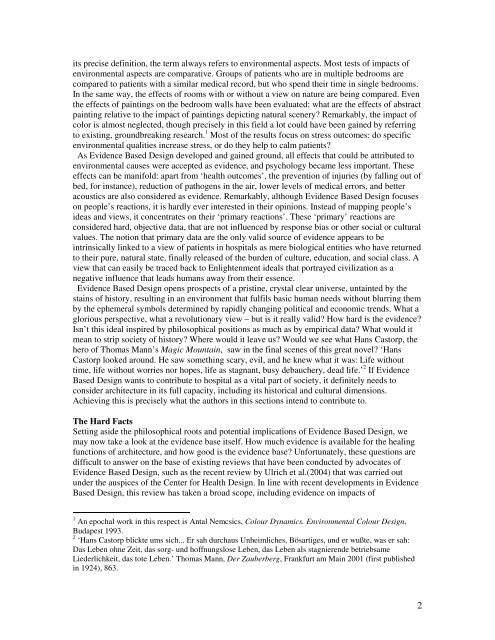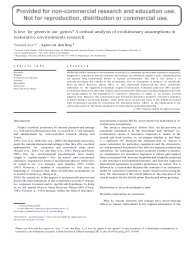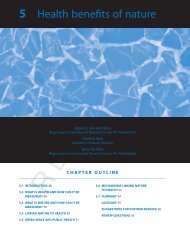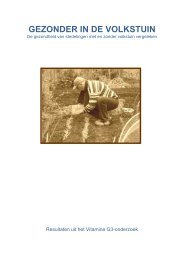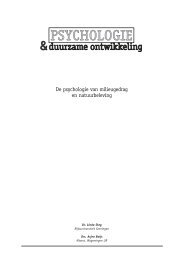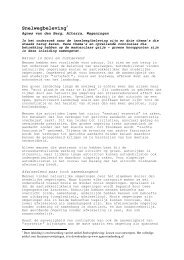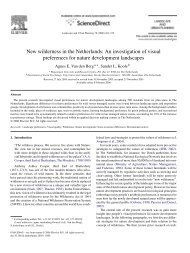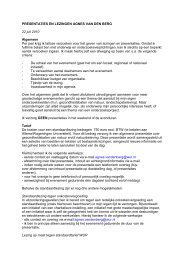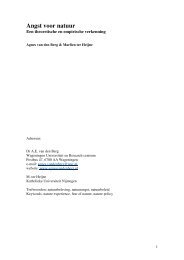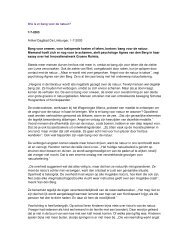Healing by Architecture Agnes van den Berg, Cor Wagenaar How ...
Healing by Architecture Agnes van den Berg, Cor Wagenaar How ...
Healing by Architecture Agnes van den Berg, Cor Wagenaar How ...
Create successful ePaper yourself
Turn your PDF publications into a flip-book with our unique Google optimized e-Paper software.
its precise definition, the term always refers to environmental aspects. Most tests of impacts of<br />
environmental aspects are comparative. Groups of patients who are in multiple bedrooms are<br />
compared to patients with a similar medical record, but who spend their time in single bedrooms.<br />
In the same way, the effects of rooms with or without a view on nature are being compared. Even<br />
the effects of paintings on the bedroom walls have been evaluated: what are the effects of abstract<br />
painting relative to the impact of paintings depicting natural scenery? Remarkably, the impact of<br />
color is almost neglected, though precisely in this field a lot could have been gained <strong>by</strong> referring<br />
to existing, groundbreaking research. 1 Most of the results focus on stress outcomes: do specific<br />
environmental qualities increase stress, or do they help to calm patients?<br />
As Evi<strong>den</strong>ce Based Design developed and gained ground, all effects that could be attributed to<br />
environmental causes were accepted as evi<strong>den</strong>ce, and psychology became less important. These<br />
effects can be manifold: apart from ‘health outcomes’, the prevention of injuries (<strong>by</strong> falling out of<br />
bed, for instance), reduction of pathogens in the air, lower levels of medical errors, and better<br />
acoustics are also considered as evi<strong>den</strong>ce. Remarkably, although Evi<strong>den</strong>ce Based Design focuses<br />
on people’s reactions, it is hardly ever interested in their opinions. Instead of mapping people’s<br />
ideas and views, it concentrates on their ‘primary reactions’. These ‘primary’ reactions are<br />
considered hard, objective data, that are not influenced <strong>by</strong> response bias or other social or cultural<br />
values. The notion that primary data are the only valid source of evi<strong>den</strong>ce appears to be<br />
intrinsically linked to a view of patients in hospitals as mere biological entities who have returned<br />
to their pure, natural state, finally released of the bur<strong>den</strong> of culture, education, and social class. A<br />
view that can easily be traced back to Enlightenment ideals that portrayed civilization as a<br />
negative influence that leads humans away from their essence.<br />
Evi<strong>den</strong>ce Based Design opens prospects of a pristine, crystal clear universe, untainted <strong>by</strong> the<br />
stains of history, resulting in an environment that fulfils basic human needs without blurring them<br />
<strong>by</strong> the ephemeral symbols determined <strong>by</strong> rapidly changing political and economic trends. What a<br />
glorious perspective, what a revolutionary view – but is it really valid? <strong>How</strong> hard is the evi<strong>den</strong>ce?<br />
Isn’t this ideal inspired <strong>by</strong> philosophical positions as much as <strong>by</strong> empirical data? What would it<br />
mean to strip society of history? Where would it leave us? Would we see what Hans Castorp, the<br />
hero of Thomas Mann’s Magic Mountain, saw in the final scenes of this great novel? ‘Hans<br />
Castorp looked around. He saw something scary, evil, and he knew what it was: Life without<br />
time, life without worries nor hopes, life as stagnant, busy debauchery, dead life.’ 2 If Evi<strong>den</strong>ce<br />
Based Design wants to contribute to hospital as a vital part of society, it definitely needs to<br />
consider architecture in its full capacity, including its historical and cultural dimensions.<br />
Achieving this is precisely what the authors in this sections intend to contribute to.<br />
The Hard Facts<br />
Setting aside the philosophical roots and potential implications of Evi<strong>den</strong>ce Based Design, we<br />
may now take a look at the evi<strong>den</strong>ce base itself. <strong>How</strong> much evi<strong>den</strong>ce is available for the healing<br />
functions of architecture, and how good is the evi<strong>den</strong>ce base? Unfortunately, these questions are<br />
difficult to answer on the base of existing reviews that have been conducted <strong>by</strong> advocates of<br />
Evi<strong>den</strong>ce Based Design, such as the recent review <strong>by</strong> Ulrich et al.(2004) that was carried out<br />
under the auspices of the Center for Health Design. In line with recent developments in Evi<strong>den</strong>ce<br />
Based Design, this review has taken a broad scope, including evi<strong>den</strong>ce on impacts of<br />
1 An epochal work in this respect is Antal Nemcsics, Colour Dynamics. Environmental Colour Design,<br />
Budapest 1993.<br />
2 ‘Hans Castorp blickte ums sich... Er sah durchaus Unheimliches, Bösartiges, und er wußte, was er sah:<br />
Das Leben ohne Zeit, das sorg- und hoffnungslose Leben, das Leben als stagnierende betriebsame<br />
Liederlichkeit, das tote Leben.’ Thomas Mann, Der Zauberberg, Frankfurt am Main 2001 (first published<br />
in 1924), 863.<br />
2


